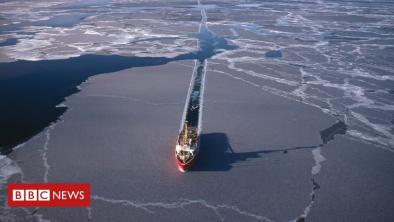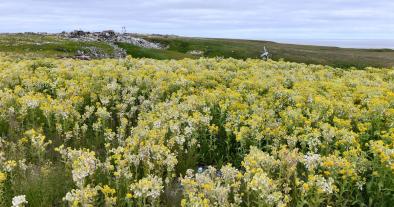
Permafrost Thaw
Permafrost is permanently frozen soil that is at risk of melting due to climate change, causing the release of even more powerful heat-trapping gases, carbon and methane, into the air. In Alaska, ground temperatures have already increased throughout the state since the late 1970s, and permafrost is thawing in many places.
Read MoreClimate science at a glance
- Warmer land surface temperatures due to human-caused warming is driving rapid permafrost thaw.
- We are already seeing the direct effects of permafrost thaw.
- Permafrost degradation is a major threat to Arctic communities and ecosystems.
- Permafrost degradation is also a major threat globally because it contributes to climate change by releasing greenhouse gases into the atmosphere that threaten to push our planet into an environmental crisis.
- Abrupt permafrost thaw is one of the most frequently discussed “tipping points”, or dramatic and irreversible changes to fundamental parts of the Earth system.
- Permafrost area decreased by 81,000 square miles per decade (or about the size of Kansas) in the Northern Hemisphere from 1921-2005, largely due to human-caused warming.
- Globally, permafrost temperature increased by 0.5°F (0.29°C) during 2007-2016.
Background
What is permafrost?
Permafrost is defined as ground that is frozen for at least two consecutive years. Permafrost occurs mostly at high elevations and high latitudes (near the poles) and can occur beneath the land surface (terrestrial permafrost) and beneath the seafloor (sub-sea permafrost).[1] About 22 percent of the land surface of the Northern Hemisphere is underlain by permafrost.
The ice content and temperature of permafrost are the key parameters that determine its physical state. Scientists use permafrost temperature, measured at a depth where seasonal variations cease to occur, as an indicator of long-term change and to represent the mean annual ground temperature.[2]
Why is permafrost thaw important?
Permafrost warming has the potential to amplify global warming, because, as permafrost thaws, microbes begin decomposing plant material in the soil releasing greenhouse gases like carbon dioxide and methane to the atmosphere. This creates a positive feedback loop where the process repeats: warming leads to permafrost melt, which releases greenhouse gases, causing more warming and so on.
In addition to causing further warming, permafrost degradation has major impacts on ecosystems, water resources, and infrastructure. For example, in Fairbanks, the second-largest city in Alaska, rising temperatures are already degrading permafrost, damaging forests as well as roads, buildings, and other infrastructure. Some climate models project that near-surface permafrost will be lost entirely from large parts of Alaska by the end of this century.[3]
US permafrost thaw trends and climate change
- (NCA 3, 2014): Permafrost lays underneath about 80 percent of Alaska’s surface. It is thickest and widespread in northern Alaska, diminishing to a permafrost-free region in the far south.[4] 70 percent of permafrost land in Alaska is vulnerable to land sinkage due to the steady rate of permafrost thaw.[4]
- (Jorgenson et al. 2010): In the arctic region of Alaska, permafrost warmed up to 5.4°F (3°C) from 1980 to 2000.[5] Over the same period in the subarctic region—home to Alaska’s boreal forest—permafrost warmed 0.5-1.8°F (0.3°C-1°C) and is already beginning to thaw.[5]
Global permafrost thaw trends and climate change
- (Biskaborn et al 2019): From 2007 and 2016, continuous permafrost ground temperature increased by 0.7°F (0.4)°C. Over the same period, discontinuous permafrost warmed by 0.4°F (0.2°C). Permafrost in mountains warmed by 0.4°F (0.2°C) and in Antarctica by 0.7°F (0.4)°C. Globally, permafrost temperature increased by 0.5°F (0.29°C).
- (IPCC, AR5, 2013): Permafrost temperatures have increased in most regions since the early 1980s in response to increased surface temperature and changing snow cover.[1]
- (IPCC, AR5, 2013): By 2100, scientists expect the area of permafrost near the surface to decrease by between 37 to 81 percent, depending on the level of 21st century greenhouse gas emissions.[1]
Global studies attribute permafrost thaw to climate change
- (Guo et al. 2020): In the Northern Hemisphere, near-surface permafrost area decreased by approximately 81,000 square miles per decade (or about the size of Kansas) during 1921-2005, largely due to human-caused warming.
- (Biskaborn et al. 2019): Rising air temperature, due to human-caused warming, is considered the most dominant control factor for permafrost change through affecting ground temperature.











